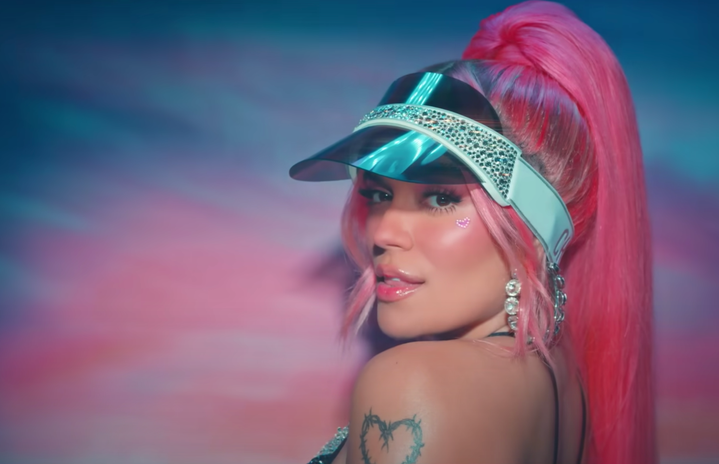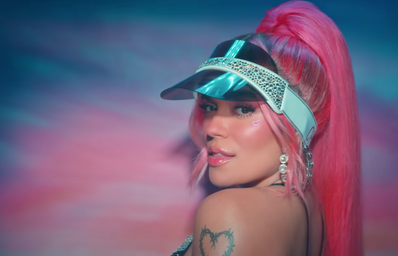The Latine community has used music of all genres from salsa to reggaeton to showcase such profound emotions and a history that runs deep through the roots of our countries. It took many centuries of music history for Latine artists to get the recognition and appreciation they deserve, but now their music resonates with people around the world.
Hispanic Heritage Month is from Sept. 15 to Oct. 15 and is used to celebrate Hispanic culture, language, art, and, most importantly in my opinion, music. So, to conclude Hispanic Heritage Month, let’s take a deep dive into six of the most influential and essential Latine artists in the music industry, both past and present.
Born on April 16, 1971, Selena Quintanilla was a vivacious singer from Texas whose contributions to music and fashion are what make her one of the most celebrated Mexican-American artists of the twentieth century. Her Mexican culture strongly influenced her style, rhythm, and lyricism.
Selena had a magnetic personality, and her stage presence made fans mesmerized as she sang about amor, life, and dance. She brought so much pride to her culture when she won her first Grammy in 1993 and was responsible for the popularization of Tejano music, a music style that uses Mexican influences. Her album Amor Prohibido gained the #1 spot on the Latin Charts in 1994, and in 2021, she was awarded the Recording Academy’s Lifetime Achievement Award.
Selena released six albums between 1989 and 1995. In 2022, her family released an album titled Moonchild Mixes that has songs featuring Selena’s old recordings from the ages of 13 and 16 that were never released.
Sadly, Selena’s rise to fame was cut short when she was tragically murdered at the age of 23 in 1995 by Yolanda Saldívar, the president of the Selena Quintanilla fan club. Her death sent shockwaves across the Latine community. But even after her death, her talent has remained undeniable and continues to inspire and influence generations of Latine artists.
Úrsula Hilaria Celia de la Caridad Cruz Alfonso, or Celia Cruz, was born in Havana, Cuba on Oct. 21, 1925. She grew up in a poor neighborhood in Havana as a child of hardworking parents and the oldest sibling of 14.
The “Queen of Salsa” was originally enrolled at the National Teachers’ College as a literature teacher before dropping out after her live and radio performances gained popularity in 1940. She then enrolled at Havana’s National Conservatory of Music and decided to pursue a singing career after being persuaded by her professors.
Cruz first rose to fame in the 1950s as the lead singer of the Sonora Matancera orchestra. Soon after, she moved to the United States in 1961 after the Cuban Revolution and continued to make music. Cruz’s breakthrough hit was “Quimbara,” released in 1974. This song was part of her collaboration with Johnny Pacheco on the album Celia & Johnny.
“Quimbara” became an iconic track and played a significant role in establishing her as a major figure in the salsa music scene. And when her first album Los Mas Grandes de Cuba was released in 1980, her career truly rocketed to the top. From there, Cruz recorded 23 gold records and 37 studio albums with musicians like Tito Puente.
Cruz lived a long life, passing away at the age of 77 on July 16, 2003. She will forever be known for infusing traditional Cuban music like son cubano and guaracha with vibrant energy and passion. Her powerful voice, charismatic stage presence, and lively performances helped define salsa music’s infectious and rhythmic style. She proudly embraced her Afro-Latin heritage, inspiring generations of Latinx artists to celebrate their roots.
Cruz continuously broke many barriers as a woman in a male-dominated genre, becoming a symbol of empowerment and cultural pride.
Born on June 7, 1957, in Santo Domingo, Dominican Republic, Juan Luis Guerra is noted as one of the most internationally recognized Dominican singer/songwriters.
He blends a pop style of Merengue, Bolero, and Afro-pop/Latin fusion, which has helped him gain so much popularity. He is also associated with the popularization of Bachata, as he uses the rhythms heavily in his music.
Guerra first began studying philosophy and literature for a year at the Universidad Autónoma de Santo Domingo. However, he soon went on to switch to the Conservatorio Nacional de Música and then moved to the United States in 1979 to continue his music education at the Berklee College of Music in Boston and study composition and arranging.
Throughout his career, he’s won 24 Latin Grammy’s, three Grammy awards, and one Latin Billboard Music Award. He has also released 14 studio albums and sold 30 million records worldwide.
Guerra is noted as an artist who is revitalizing, blending genres, and always experimenting. His complex and poetic lyrics raise awareness about issues like poverty, economic injustice, healthcare struggles, and inequality in Latin America and the Caribbean. His work not only reshaped how people viewed Dominican and Latin music, but also demonstrated the power of music in cultural and social change.
Kali Uchis is a Colombian-American singer-songwriter known for blending music that fuses R&B, reggaeton, neo-soul, and alternative pop.
Karly-Marina Loaiza (Kali Uchis) was born on July 17, 1994, in Alexandria, Virginia. She was raised between the U.S. and Colombia, which influenced her bilingual and multicultural sound. She came from a chaotic home life, growing up with four older siblings and many relatives. However, Uchis had a rebellious streak that later caused her parents to throw her out, resulting in her having to live out of her car.
She first gained popularity with her debut mixtape Drunken Babble in 2012 which showcased her unique style and influence. However, it is said that her first album, Isolation (which was critically acclaimed for its mix of genres and featured collaborations with artists like Tyler, the Creator, Jorja Smith, and Bootsy Collins), solidified her as a budding talent in the music industry.
Kali continued to innovate with a multitude of genres, blending bilingual sounds and creating music that crossed cultural and linguistic barriers. Her ability to switch between English and Spanish in her songs allows her to expand Latin music to reach both Latinx and non-Latinx audiences.
In her music, she explores themes of empowerment, sexuality, and self-discovery while embracing her Latina identity and resisting being boxed into expectations for Latin artists. She brings modern feminism and perspective to her music. And so far, Kali has released four studio albums as of 2024 and won several awards, including a Grammy in 2021 and a Billboard Latin Music Award in 2023.
The “música urbana” artist originally had trouble succeeding in the male-dominated genre that is reggaeton. Just to help herself and her career begin, she performed as a background singer at festivals.
Karol G, originally named Carolina Giraldo Navarro, was born in Medellín, Colombia, on Feb. 14, 1991. She grew up listening to music of different genres and even performed with her father, Juan Guillermo Giraldo. She then went on to study music at the University of Antioquia.
She is one of the leading figures in the Latin music urban scene, gaining international fame from collaborating with artists like Bad Bunny, Nicki Minaj, and Shakira. But her breakthrough really began when she gained recognition in 2017 with the release of her single “Ahora Me Llama” featuring Bad Bunny, which became a huge hit.
Karol G has released four studio albums, with her most recent coming out in 2023, and she became the most-streamed female Latin artist on platforms like Spotify in 2020. This achievement was fueled by the massive success of her hit single “Tusa” featuring Nicki Minaj, which became a global sensation. The song was able to top the charts worldwide and helped her gain success and rise to the top of the Latin music scene.
Her music continues to empower Latina woman, as she is a lead figure in the reggaeton and Latin trap genres — a group that has historically been dominated by male artists. She diversifies the genres and challenges the traditional machismo influence. Her lyricism also often challenges beauty standards commonly portrayed in the entertainment industry and associated with Latina women. Additionally, she has been known to use her platform to encourage her fans to embrace their individuality, culture, and emotions.
Bad Bunny has been one of the hottest Latino artists on the rise within the past six years.
The Puerto Rican musician, named Benito Antonio Martínez Ocasio, was born on March 10, 1994 in Vega Baja, Puerto Rico. His father, a truck driver, and mother, an English teacher, raised him in a lower middle-class life in Vega Baja’s Almirante Sur neighborhood.
Growing up in Puerto Rico heavily influenced Bad Bunny’s style and persona. He has redefined the reggaeton and trap music genres by infusing them with socially conscious themes and experimenting with other genres like rock, punk, and electronic.
As an artist, he tends to break gender stereotypes and speaks out against social and political issues, especially issues on his home island. This has allowed him to greatly expand his reggaeton narrative and help make him a global success.
He first began releasing music in 2013 as a college student at the University of Puerto Rico at Arecibo studying audiovisual communication and working as a grocery store bagger. At his start, he would simply upload his music to Soundcloud, which in turn helped him gain attention in his craft.
His breakthrough came in 2016 when DJ Luian discovered his song “Diles” on Soundcloud, which earned him a spot on his label, Hear This Music. From there, Bad Bunny released five studio albums and one collaborative album, Oasis, in 2019. In his music career, Bad Bunny has won multiple Latin Grammys and Billboard Music Awards along with several other prestigious music achievements.
In such a short period of time, he has become a powerful symbol of the community. He empowers youth and marginalized communities and has become a symbol for Latinx youth and the LGTBQ+. He pushes social and creative boundaries with his approaches to music, culture, and activism. And finally, he represents a new era of Latin artists who are unapologetically themselves and staying true to their roots
Together, these artists have expanded the reach of Latin music, blending it with diverse styles and introducing it to new audiences worldwide. They’ve embraced their cultural roots while adapting to modern trends, ensuring that Latin music continues to evolve and resonate globally.


